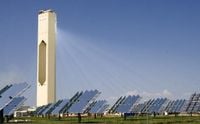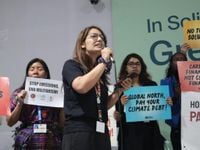The world’s attention has turned to Belém, Brazil, where the 30th United Nations Climate Change Conference (COP30) is unfolding amid a swirl of hope, frustration, and urgent calls for justice. While the Amazon’s lush canopy provides a dramatic backdrop for high-stakes negotiations, the absence of the United States—the world’s largest historical emitter and second-largest current polluter—casts a long shadow over proceedings. Yet, in the face of political retreat and mounting disinformation, climate leaders and grassroots activists, especially women from the Global South, are forging ahead with determination and innovation.
According to The Diplomat, the U.S. withdrawal from the Paris Agreement under President Donald Trump earlier this year marked a significant step back for global climate diplomacy. President Trump’s administration, which received $75 million in campaign donations from the fossil fuel industry, has not only expanded fossil fuel extraction but has also dismissed international climate commitments as “an unfair one-sided Paris climate accord rip off.” This stance has left the U.S. largely absent from COP30’s leadership ranks, a fact noted by True You’s Roberto Valadéz, who wrote, “The United States is notably absent from high-level leadership at COP30, having withdrawn from the Paris Agreement under President Trump.”
The repercussions of this retreat are far-reaching. As Ranjana Giri, a climate justice officer with the Asia Pacific Forum on Women, Law and Development (APWLD), told The Diplomat, “The dwindling commitment of the United States and other powerful Global North governments has placed additional strain on global climate justice efforts.” Giri argues that this abdication perpetuates a pattern of “Western imperialism and climate colonialism,” as wealthy nations protect their own development priorities while shifting climate burdens onto the Global South.
Despite these headwinds, COP30 has not been devoid of American engagement. Subnational leaders like Senator Sheldon Whitehouse of Rhode Island and California Governor Gavin Newsom have made their presence felt, signaling ongoing U.S. involvement at other levels. “California is a stable and reliable partner,” Newsom declared, highlighting the state’s leadership in renewable energy and its outsized economic clout.
Yet, the urgency of the moment is underscored by a sobering United Nations report released this year. The report warns that delayed and insufficient action has set the world on a trajectory toward 2.8 degrees Celsius of warming—well above the Paris target of 2 degrees. Even if all new national pledges are fulfilled, projections only improve to a range of 2.3 to 2.5 degrees. The consequences of such overshoot are dire: the loss of coral reefs, irreversible ice melt, and the crossing of planetary tipping points.
Complicating matters further is the explosion of climate disinformation. As True You reports, there was a staggering “267% increase in COP-related disinformation circulating in media and online from July to September 2025.” President Trump has been among the most vocal skeptics, labeling climate change “the greatest con job ever perpetrated on the world.” In response, 12 countries have signed the Declaration on Information Integrity on Climate Change, pledging to combat denialism and ensure the accuracy of climate information.
Against this turbulent backdrop, women across Asia and the Global South are stepping up with practical, community-driven climate solutions. Giri describes how women in Bangladesh, Vietnam, and the Philippines are innovating with solar-powered agriculture, seed saving, and mangrove replanting. In Back Ken, Vietnam, indigenous women have adopted solar drying systems for their food businesses, reducing the need for charcoal and deforestation. In Bangladesh’s Chuadanga district, women goat farmers now use solar pumps for livestock and crops, improving their resilience and livelihoods.
These grassroots efforts are not just acts of survival—they are blueprints for a more just and sustainable future. “Across Asia, women are leading wide-ranging climate responses within their communities,” Giri said. “While much of this work is informal and largely unrecognized in official policy spaces, it remains essential for community survival.”
But the challenges are immense. Women in coastal and riverine areas face sea level rise, saltwater intrusion, and soil salinization, which threaten both food security and traditional livelihoods. In mountainous regions like Nepal, glacier retreat and unpredictable rainfall increase the risks of floods and landslides. Urban women, particularly those in informal settlements, contend with extreme heat, poor housing, and unreliable services—all exacerbated by climate change. Displacement, often caused by climate disasters or so-called “green” infrastructure projects like large hydropower dams, disproportionately burdens women, who must secure food, water, and care for families under ever more difficult conditions.
National climate strategies, while abundant on paper, often fail to address the intersectional needs of women, Indigenous Peoples, and marginalized communities. These policies, Giri notes, “lack gender responsiveness, ignore intersectional needs, overlook community knowledge, and further exacerbate the marginalization of already vulnerable communities.” The influence of corporate actors—agribusiness giants like Bayer, JBS, and Nestlé, as well as fossil fuel lobbyists—has grown within COP negotiations, shaping outcomes to favor their interests over those of communities on the frontlines.
Despite the odds, there are reasons for optimism. For the first time in history, renewable energy contributed more to global electricity generation than any other source in 2025, according to True You. The rapid deployment of wind, solar, and battery technologies is projected to double global renewable power capacity within the next five years, adding roughly 4,600 gigawatts—equal to the combined capacity of China, the EU, and Japan. Al Gore’s Climate TRACE initiative, which uses AI and satellite imagery to pinpoint high-polluting facilities, offers a “ready-made blueprint” for accelerating emissions reductions. If adopted, its recommendations could save up to 20.5 billion metric tons of CO2 by 2050, roughly half of current annual global emissions.
Financing remains a major sticking point. The host country’s Tropical Forest Forever Facility (TFFF) aims to attract $125 billion for forest conservation, reframing it as an investment opportunity. Major institutions like the European Bank for Reconstruction and Development and the Asian Infrastructure Investment Bank are considering participation. Yet, as The Diplomat highlights, the gap between projected climate losses—up to $59 trillion by 2050—and actual funds raised for Loss & Damage ($261 million so far) is vast. Grassroots groups often find themselves locked out of these flows, as eligibility criteria and reporting requirements favor large, international organizations.
For many, the solution lies in a “just transition”—a transformation that centers justice, equity, and community leadership. This means shifting away from extractive economies, recognizing women’s unpaid labor, and ensuring that energy systems serve people, not just industries. Redistribution of land, genuine free and informed consent, and debt relief for the Global South are all seen as essential steps.
As COP30 heads toward its conclusion, the world is watching to see whether political resolve can finally unlock the opportunities that climate champions have long promised. In the words of Valadéz, “the global commitment to climate stability is proving resilient, despite formidable headwinds.” The voices of women, Indigenous Peoples, and frontline communities are rising—demanding that this time, the future be written by those who have the most at stake.


